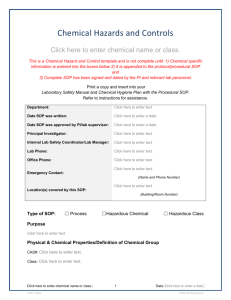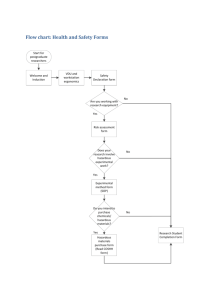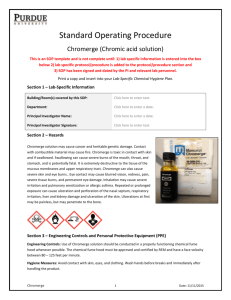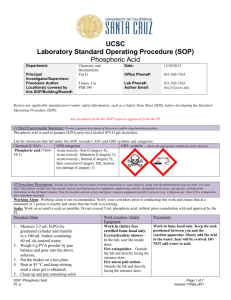ISEM SOP TEMPLATE - Environmental Health & Safety
advertisement
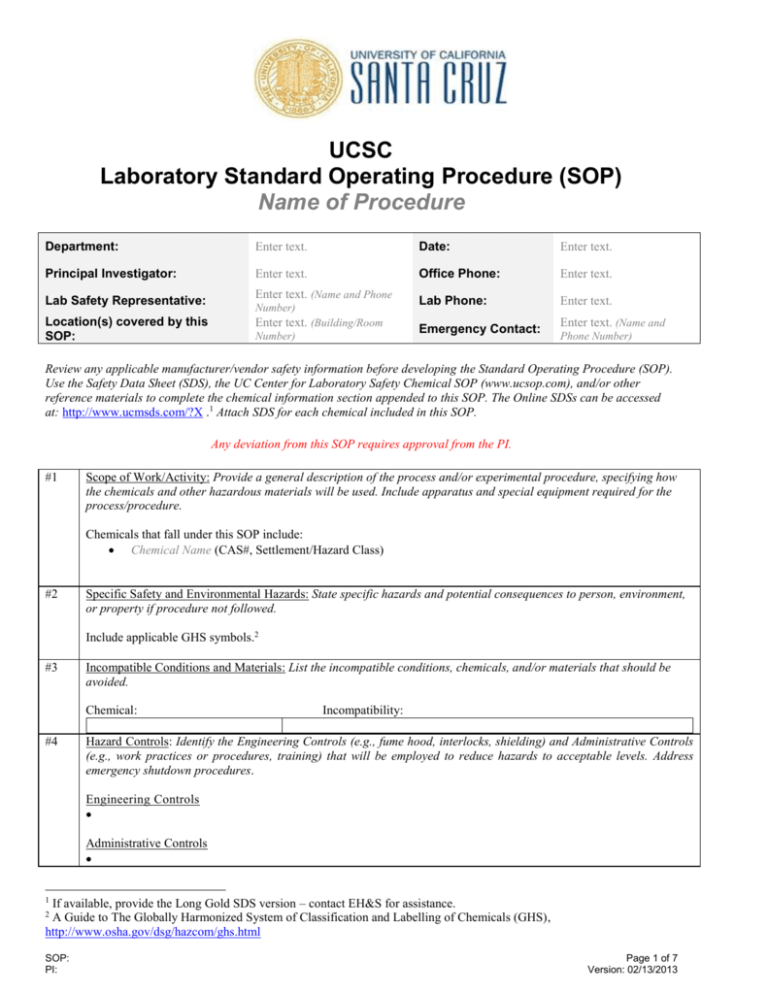
UCSC Laboratory Standard Operating Procedure (SOP) Name of Procedure Department: Enter text. Date: Enter text. Principal Investigator: Enter text. Office Phone: Enter text. Lab Phone: Enter text. Emergency Contact: Enter text. (Name and Lab Safety Representative: Location(s) covered by this SOP: Enter text. (Name and Phone Number) Enter text. (Building/Room Number) Phone Number) Review any applicable manufacturer/vendor safety information before developing the Standard Operating Procedure (SOP). Use the Safety Data Sheet (SDS), the UC Center for Laboratory Safety Chemical SOP (www.ucsop.com), and/or other reference materials to complete the chemical information section appended to this SOP. The Online SDSs can be accessed at: http://www.ucmsds.com/?X .1 Attach SDS for each chemical included in this SOP. Any deviation from this SOP requires approval from the PI. #1 Scope of Work/Activity: Provide a general description of the process and/or experimental procedure, specifying how the chemicals and other hazardous materials will be used. Include apparatus and special equipment required for the process/procedure. Chemicals that fall under this SOP include: Chemical Name (CAS#, Settlement/Hazard Class) #2 Specific Safety and Environmental Hazards: State specific hazards and potential consequences to person, environment, or property if procedure not followed. Include applicable GHS symbols.2 #3 Incompatible Conditions and Materials: List the incompatible conditions, chemicals, and/or materials that should be avoided. Chemical: #4 Incompatibility: Hazard Controls: Identify the Engineering Controls (e.g., fume hood, interlocks, shielding) and Administrative Controls (e.g., work practices or procedures, training) that will be employed to reduce hazards to acceptable levels. Address emergency shutdown procedures. Engineering Controls Administrative Controls If available, provide the Long Gold SDS version – contact EH&S for assistance. A Guide to The Globally Harmonized System of Classification and Labelling of Chemicals (GHS), http://www.osha.gov/dsg/hazcom/ghs.html 1 2 SOP: PI: Page 1 of 7 Version: 02/13/2013 Working alone restrictions: Precautions for safe handling: - Wash hands after working with x, even if gloves were used. Conditions for safe storage: Training & Competency Requirements Complete EH&S online or instructor-led “Introduction to Laboratory Safety” class Review and sign Lab-Specific Training Checklist with PI, Lab Safety Representative, or other designated person. Review SOP with knowledgeable person. Complete training on specialized equipment prior to use (e.g., ultracentrifuge, hydrogenation apparatus). Other EH&S training requirements (e.g., Biosafety, Radiation Safety, Hazardous Waste Management) Decontamination/Clean-Up Wash bench and/or work area with soap and water after using. #5 Emergency shutdown procedure Personal Protective Equipment (PPE): State the personal protective equipment selected and required. Examples: safety glasses, goggles or face shield; lab coat; specific gloves; chemical-proof apron; respiratory protection. Eye Protection: ANSI-approved properly fitting safety glasses or goggles. Chemical splash goggles and/or full face shield during activities which pose a splash hazard. Skin and Body Protection: Appropriately-sized lab coats must be worn and buttoned to their full length. Laboratory coat sleeves must be of sufficient length to prevent skin exposure while wearing gloves. Full length pants and closed-toe shoes must be worn at all times by all individuals within the laboratory area. The area of skin between the shoe and ankle should not be exposed. Check box for type of lab coat: Flame Resistant 100% cotton Hand Protection: Wear nitrile gloves; remove gloves and wash hands with soap and water after use. For incidental splash protection, wear double gloves. Remove gloves immediately after contact with chemical(s) and wash hands. If direct contact is anticipated, consult with EH&S to identify appropriate protective gloves. Use the SDS and refer to glove selection chart from the link to determine appropriate glove selection: http://www.microflex.com/Products/~/media/Files/Literature/Domestic%20Reference%20Materials/DOM_Reference_C hemical%20Resistance.ashx Additional Protection: #6 Designated Area: Indicate the area designated for performing this process in the laboratory. #7 Important Steps to Follow: Provide the steps for the procedure from obtaining the specific reagent bottles to returning those bottles to the appropriate storage location. List the specific sequence of steps required or recommended to mitigate potentially hazardous conditions. In addition, note location and use of any emergency response equipment specific to process (e.g., Calgonate gel, Class D fire extinguisher, inert absorbent material). Include information for special handling and storage requirements. #8 Spill Clean-Up Procedures (reference appended SDS as needed): SOP: PI: Page 2 of 7 Version: 02/13/2013 Do not attempt to clean up any spill or release for which you are not fully trained and equipped. For assistance with spill cleanup, dial and ask dispatch to page EH&S. Isolate the area to prevent the spread of contamination (e.g. close doors to affected area, post warning signs, alert others in immediately vicinity to evacuate). Prevent spill from reaching drains or from spilling outside of the fume hood if possible to do so without exposing yourself to liquid or vapor. Clean the affected area and all exposed equipment with soap and water to remove any contaminants before resuming work. Spill clean-up materials should be disposed of as hazardous waste. Provide specific Clean-Up Information: #9 Hazardous Waste(s): List expected concentrations and amounts of hazardous waste(s) generated during this process. Contact EH&S for specific guidance regarding hazardous waste handling and disposal. General hazardous waste management guidelines: http://ehs.ucsc.edu/programs/wastemanagement/index.html Waste Labeling Affix an on-line hazardous waste tag on all waste containers using the Online Tag Program (OTP) http://otp.ucop.edu/ as soon as the first drop of waste is added to the container. Waste Storage Store hazardous waste in closed containers, in clean secondary containment, segregated by hazard class, in a marked and designated waste accumulation area. Double-bag dry waste using transparent bags. Waste accumulation area must be under the control of the person generating the waste. Waste Disposal Hazardous waste must be removed from the lab within 180 days. Containers must be clean, sealed, and safe to transport. Mark container as ready for pick up in OTP, move container to accumulation area. Contact EH&S at x9-3086 for questions. #10 First Aid / Emergency Procedures: Describe immediate First Aid or medical treatment required in case of personnel exposure. For immediate medical assistance, dial . Report all serious injuries to EH&S as soon as possible. If inhaled, move into fresh air immediately. In the case of eye or skin contact, flush with water for a minimum of 15 minutes. Ensure that eyelids are held open while rinsing eyes. If ingested, flush mouth with water (only if the person is conscious). In the case of a needlestick/puncture injury, wash the affected area with soap and warm water for 15 minutes. For employees, follow the instructions at the Risk Services website: http://risk.ucsc.edu/workers-comp/reporting-and-treatment.html Seek medical attention immediately. Complete incident report form, http://risk.ucsc.edu/all-forms/wc-incident-report-form.pdf, (contact EH&S) and/or follow the instructions at the Risk Services website: http://risk.ucsc.edu/workers-comp/reporting-and-treatment.html Laboratory Emergency Response Equipment: All research personnel must know location of nearest fire alarm pull station and emergency shower/eyewash. Do not use fire extinguisher unless you are trained to do so. List locations for nearest fire alarm pull and emergency shower/eyewash. SOP: PI: Page 3 of 7 Version: 02/13/2013 As the Principal Investigator, it is your responsibility to ensure that all individuals conducting this protocol are taught the correct procedures for safe handling of the hazardous materials involved. It is also your responsibility to ensure that your personnel complete Laboratory Safety Training and other applicable safety training courses. I have reviewed and approve this Standard Operating Procedure. PI Signature: DATE Note that personnel associated with the protocol must sign the acknowledgement at the end of this document. SOP: PI: Page 4 of 7 Version: 02/13/2013 Chemical Information Summary Provide information for all chemicals included in the SOP. See attached SDS for detailed toxicity information. Physical & Chemical Properties Chemical CAS# Class Molecular Formula Structure Molecular Weight (g/mol) Density (g/mL) Form (physical state) Melting Point (ºC) Boiling point (ºC) Flash point (ºC) Exposure Limits/Toxicity Data Chemical SOP: PI: Color Odor Cal/OSHA PEL Toxicity LD50 Page 5 of 7 Version: 02/13/2013 Documentation of Training (signature of all users is required) Prior to conducting any work with chemical name, class, or process, the PI or designee must provide training to his/her laboratory personnel regarding the specific hazards involved in working with this substance, work area decontamination, and emergency procedures. The Principal Investigator must provide his/her laboratory personnel with a copy of this SOP and a copy of the SDS provided by the manufacturer. The Principal Investigator must ensure that his/her laboratory personnel have attended appropriate laboratory safety training or refresher training within the last year. I have read and understand the content of this SOP: Name SOP: PI: Signature Date Page 6 of 7 Version: 02/13/2013 (Add further signature lines as necessary) SOP: PI: Page 7 of 7 Version: 02/13/2013
